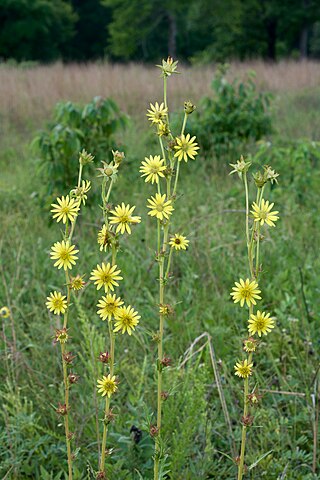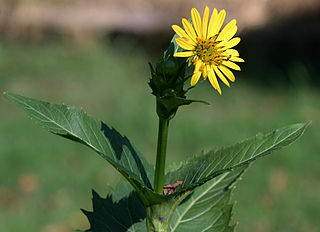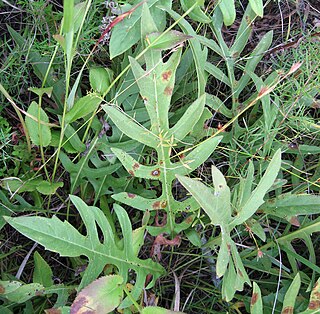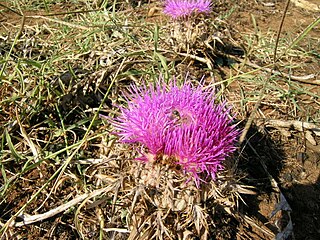
Silphium is an unidentified plant that was used in classical antiquity as a seasoning, perfume, aphrodisiac, and medicine.

Silphium is a genus of North American plants in the tribe Heliantheae within the family Asteraceae.

Silphium laciniatum is a species of flowering plant in the family Asteraceae known commonly as compassplant or compass plant. It is native to North America, where it occurs in Ontario in Canada and the eastern and central United States as far west as New Mexico. Other common names include prairie compass plant, pilotweed, polarplant, gum weed, cut-leaf silphium, and turpentine plant. It is a rosinweed of genus Silphium.

The heart symbol is an ideograph used to express the idea of the "heart" in its metaphorical or symbolic sense. Represented by an anatomically inaccurate shape, the heart symbol is often used to represent the center of emotion, including affection and love, especially romantic love. It is sometimes accompanied or superseded by the "wounded heart" symbol, depicted as a heart symbol pierced with an arrow or as a heart symbol "broken" into two or more pieces, indicating lovesickness.

Bolax is a genus of flowering plant in the family Apiaceae. Two species are currently accepted by Plants of the World Online. It is endemic to temperate South America.
Marlothiella gummifera is a species of flowering plant in the family Apiaceae, and the only species in the monotypic genus Marlothiella. It is endemic to Namibia, where its natural habitats are rocky areas and cold desert. It is also the only genus in the tribe Marlothielleae, of the subfamily Apioideae.

Corymbia gummifera, commonly known as red bloodwood, is a species of tree, rarely a mallee, that is endemic to eastern Australia. It has rough, tessellated bark on the trunk and branches, lance-shaped adult leaves, flower buds in groups of seven, creamy white flowers and urn-shaped fruit.
Thapsia buraensis is a species of air-breathing land snail or semi-slug, a terrestrial pulmonate gastropod mollusk in the family Urocyclidae.

Thapsia is a genus of air-breathing land snails, terrestrial pulmonate gastropod mollusks in the subfamily Sheldoniinae of the family Urocyclidae.

Gardenia gummifera is a species of plant in the family Rubiaceae. It is endemic to India.

Silphium asteriscus, commonly called starry rosinweed, is an herbaceous plant in the family Asteraceae. It is native to the eastern United States, from Oklahoma and Texas east to Florida and Pennsylvania. It is a widespread species found in a variety of open habitats, such as prairies and woodlands.

Silphium perfoliatum, the cup plant or cup-plant, is a species of flowering plant in the family Asteraceae, native to eastern and central North America. It is an erect herbaceous perennial with triangular toothed leaves, and daisy-like yellow composite flower heads in summer.

Thapsia, commonly known as the deadly carrots, is a small genus of poisonous plants in the family Apiaceae. Their center of diversity is around the western Mediterranean, extending into the Atlantic coasts of Portugal and Morocco. Some species are used in traditional medicine.

Thapsia villosa, commonly known as the villous deadly carrot, is a species of poisonous herbaceous plants in the genus Thapsia. It grows to about 70 to 190 cm in height. It has pinnate hairy leaves with sheath-like petioles. The flowers are yellow in color and borne on compound umbels. They develop into fruits with four wings characteristic of the genus. It is native to southwestern Europe and northwestern Africa surrounding the Mediterranean Sea. The plant was used extensively for traditional medicine since around the 3rd century BC.

Silphium pinnatifidum, the tansy rosinweed or cutleaf prairie dock, is a species of flowering plant in the family Asteraceae. It is native to the Southeastern United States where it is found in Alabama, Georgia, Kentucky, and Tennessee. Its habitat is prairies, barrens, and cedar glades.

Silphium mohrii, known by the common names Mohr's rosinweed and shaggy rosinweed, is a species of flowering plant in the family Asteraceae. It is native to the Southeastern United States, where it is native only to northern Alabama, southern Tennessee, and extreme northwest Georgia. It is native to prairie remnants and rocky limestone openings. Because of its restricted range and severely declined habitat, it is considered a vulnerable species.

Silphium terebinthinaceum is a member of the Asteraceae, a family that includes sunflowers, and is commonly referred to as prairie dock or prairie rosinweed. It is native to central and eastern North America. "Rosinweed" became one of the plant's common names due to the fact that upon injury, resin flows from the wound, giving the plant a sweet smell. Tea brewed from the roots of the prairie dock have a variety of medical applications in Native American culture. The smoke from this plant has also been used as a treatment for congestion and rheumatism.

Chamaeleon gummifer, also known as distaff thistle or stemless atractylis, is a thistle in the Chamaeleon genus. Formerly, it was placed in the Atractylis genus. It is native to the Mediterranean basin, where it can be found in various habitats, including cultivated- or uncultivated fields and forests. It is a perennial herb producing a stemless, pinkish flower. The plant has a history of use in folk medicine, but it is very toxic due to the presence of atractyloside and carboxyatractyloside.
Silphium perplexumJ.R.Allison is a prairie species in the Asteraceae endemic to the state of Alabama. S. perplexum is commonly known as Old Cahaba rosinweed, a reference to the Cahaba River near which all populations of this species are found.

Silphium integrifolium is a species of flowering plant in the family Asteraceae. Its common names include rosinweed, whole-leaf rosinweed, entire-leaf rosinweed, prairie rosinweed, and silflower. It is native to eastern North America, including Ontario in Canada and the eastern and central United States as far west as New Mexico.


















